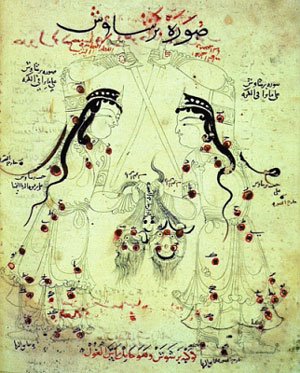
I have always enjoyed visiting the
Institut du monde arabe in Paris. They now have an exhibit,
L'âge d'or des sciences arabes, on science in the Arab golden age, which displays 200 objects from the 8th to the 15th century. I learned about this from an article by Eric Biétry-Rivierre (
Au temps où l'arabe régnait sur les sciences, October 25) in
Le Figaro (my translation):
Between the 8th and 15th centuries, a linguistic community reached its apogee from the heights of the Pyrenees to Samarkand. Avicenna [Abu Ali Sina], Averroes [Ibn Rhusd], Rhazes [Al Razi], Alhazen [Abu Ali al-Hasan Ibn Al-Haitham], and many other scholars, of very diverse regional and religious backgrounds, were such striking lights together that it is enough, even today, simply to remember them to show that fanatical Islam is nothing more than an obscurantism. There are those doing that today, but they are too rare. One of them is Ahmed Djebbar, the scholarly curator of the exhibit. This mathematician and historian of science, teaching at the Université de Lille, was the Minister of Education and Research in Algeria and counselor to President Mohammed Boudiaf, assassinated in 1992.
Working during that too brief moment of hope during the civil war that ravaged that country, he is the model of the perfectly honest man, a well of science and enthusiasm. Through his voice we hear the voice of the great encyclopedic sages of the golden age, such as Abou el Rihan al-Bayrouni, a genius who knew just about everything there was to know in this period, around 973 to 1048, and who calculated the Earth's diameter flawlessly and even discussed the possibility that the Earth rotated, well before Galileo.
In another article (
Beautés et secrets de l'astrolabe et de l'alambic, October 25) in
Le Figaro, the same author gives a little more information on the objects on exhibit. He praises the curatorial work, in particular, found in the extensive documentation with each object, especially the audiovisual aids. If you cannot make it to Paris before March 19, you can peruse a few images in the
Galerie Virtuelle on the Institut's Web site.
 I have always enjoyed visiting the Institut du monde arabe in Paris. They now have an exhibit, L'âge d'or des sciences arabes, on science in the Arab golden age, which displays 200 objects from the 8th to the 15th century. I learned about this from an article by Eric Biétry-Rivierre (Au temps où l'arabe régnait sur les sciences, October 25) in Le Figaro (my translation):
I have always enjoyed visiting the Institut du monde arabe in Paris. They now have an exhibit, L'âge d'or des sciences arabes, on science in the Arab golden age, which displays 200 objects from the 8th to the 15th century. I learned about this from an article by Eric Biétry-Rivierre (Au temps où l'arabe régnait sur les sciences, October 25) in Le Figaro (my translation):
No comments:
Post a Comment